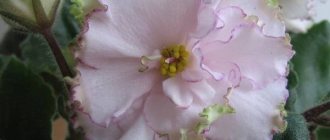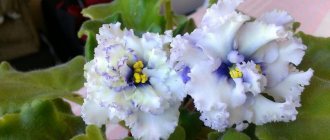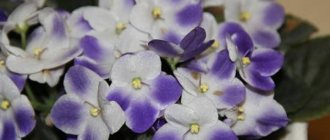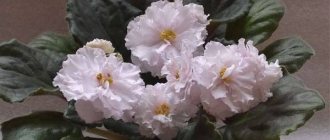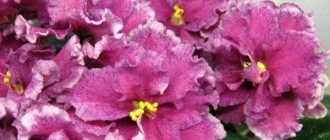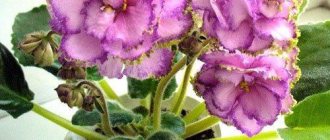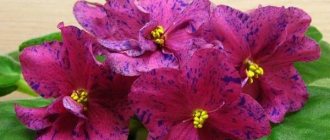The authors who created all the presented varieties are breeders Paul and Sidney Sorano, .
The varieties were bred in the Sorano family's Lyndon Lyon in Dolgeville, New York, USA, which Paul has run since 1982, following the retirement of his grandfather Lyndon Waldo Lion, the founder of the beautiful family business. The described varieties of Saintpaulias of these masters are included in the conventional group with the prefix “Lyon's” and invariably find their admirers among collectors all over the world.
Violet Lyon's Zoe (2013), Paul Sorano
Description of violet
An elegant and strong variety in rich colors represents exhibition variations of Saintpaulia standards with enlarged forms.
From the beginning of its development, the violet independently organizes the bush in spread-out compact contours, which helps it create a neat checkerboard configuration of an adult rosette.
The medium-sized leaves have a heart-shaped oval shape with a neatly pointed tip, a textured quilted dense-glossy layer, a strong jagged edge and frequent venation in the form of a pressed mesh, creating a voluminous tuberosity of the plate.
The configuration of the leaves suggests they are slightly curved like a spoon. The color background of the plates is represented by rich dark tones of malachite. The reverse side has a reddish highlight.
ATTENTION! The highlight of the color scheme of the chic hats is the use of intense shades of the reddish-burgundy palette to color the extremely terry “star” corollas.
The smooth velvety background of the main part of the petals ends with a snow-white braid running along the wavy edges.
in this variety .
Features of maintenance and care
The variety belongs to variations of the genus with simple care and an absolutely non-capricious reaction to its use. The violet has several features that emphasize its magnificence:
- itself ennobles an almost exhibition rosette;
- bears heavy flowers on strong straight peduncles;
- does not change the richness of the shades of the corollas;
- loves to bloom unusually - violently and for a long time.
Violets do not harm the chic decorative effect:
- small folding of leaves into a “boat”;
- lumpy rosette background.
Reviews
Klara Romanovna. “The Lyon's Zoe violet is a real work of art, a royal variety. I advise everyone!"
The remaining varieties belong to the selection of Sidney Sorano.
Reproduction at home
You can propagate Eschynanthus Mona Lisa yourself by cuttings or seeds. Experts recommend the first method, since it is much easier to implement.
To do this, you must adhere to the following algorithm of actions:
- Place cut shoots with 2–3 nodes and a length of 5–6 cm in a container with a substrate (a mixture of peat, sand, moss in a 1:1:1 ratio), having previously treated the cuttings with a growth stimulator “Kornevin”, “Epin”, etc.
- Cover the top with plastic wrap or a glass jar.
- Keep at a temperature of +26°C.
- Watering is done through the tray.
- Ventilate the seedlings periodically.
- Remove the film after the roots appear on the seedlings.
The second method is used very rarely and is as follows:
- Sow the seeds into the prepared substrate and cover with film.
- Keep in a well-lit place at a temperature of +23...+25°C.
- Water into the tray.
- After seed germination, seedlings need to be ventilated periodically.
- After 2–3 weeks, the film should be removed.
- Transplant the seedlings into separate pots.
Violet Lyon's Lavender Magic (2003)
Description of the variety
The violet silhouette is a format that is light in nature, suitable for growing without whims in the collections of all gardeners of a large-standard Saintpaulia : it is independently filled with a dense, tiled volume of leaves, becoming a neat plant with ideally all-round symmetry.
The fleecy-shiny oversized leaves of an elongated heart-shaped structure have a noticeable, medium-distinct serration of contours, textured quilting and clearly outlined graphics of the veins.
The color background of the leaf plates is distinguished by the rich color scheme of darkened grass, and their structure is of sufficient density. The leaf padding has a reddish sheen. The tips of the plates can bend towards the flowerpot.
The hallmark of Saintpaulia is rich caps of extremely large, simple, less often semi-double “star” flowers in structure, the wavy petals of which have fringed frills along the edge. The corollas of the white variety are decorated with large prints in delicate shades of lilac and lavender.
Sports
Saintpaulia is capable of sporting very rarely : it forms corollas with petals that are remarkably corrugated at the edges, wrapped in a tube, and the color of the prints is closer to a violet tone.
Features of development and care
The variety has a relatively calm character ; in cultivation it is distinguished by its unpretentiousness and independence in terms of the design of a large-textured bush.
He is very hardworking and produces multiple buds early . The corollas last for about a month, but their thin stalks can lie on the rosette.
INTERESTING! The temperature of keeping Saintpaulia directly affects the decorative appearance of its caps: the color of the corollas in the heat takes on an even shade of lavender, and the white background of the petals becomes more pronounced the cooler the room.
Reviews
Peter Ionovich. “A significant advantage of the Lyon's Lavender Magic variety is active flowering from the first budding of the specimens.”
Home care
In order for a flower to have a beautiful and healthy appearance, it needs to be provided with proper care, which includes regular watering, fertilizing, pruning bushes and timely replanting.
Did you know? Aeschynanthus is also called the “lipstick flower” because of its purple bracts that resemble lipstick.
Watering
Eschenanthus should be watered moderately when the top layer of soil dries out. This is done 1-2 times a week with water at room temperature, always left to stand for 1-2 days. It is important not to allow the soil to become waterlogged and do not forget to drain the remaining water in the pan, avoiding stagnation.
Fertilizer application
It is recommended to feed eschynanthus during flowering 1-2 times a month, and it is better to apply fertilizers directly to the soil, thereby preventing burns to the roots. It is best to use mineral fertilizers such as “Zelenit” (100 ml per 10 liters of water) or “Rose” (2 scoops per 10 liters of water).
Trimming
To make the flower look beautiful and aesthetically pleasing, it must be trimmed periodically. After the plant has flowered, long and outdated shoots are removed, which gives the young branches the opportunity to grow better and form more flowers.
Check out the beautiful aeschynanthus.
Transfer
It is advisable to replant the flower every spring during the warm season; it is better to do this after pruning. Eschinanthus Mona Lisa prefers tight containers, so the next pot should be only 2–3 cm wider than the previous one. The soil can be bought at a flower shop, or can also be prepared at home.
To do this, you need to mix humus, sand, peat and leaf soil in a ratio of 1:1:1:2. You can also add a little charcoal or pine bark for better air permeability. You need to put pebbles or expanded clay at the bottom of the pot as drainage.
Important! It is necessary to replant the flower using the transshipment method, thereby preventing damage to the roots.
Violet Lyon's Crown Jewel (1996)
Description of the variety
An impressive two-color retro violet withstands the enlarged gradient of standard scales and has a compact rosette shape with regular silhouette contours that independently manifests itself with age.
The leaves of the middle range in the shape of a smooth, elongated-pointed oval are characterized by a significant voluminous wavy surface of a glossy texture, teeth clearly visible along the contour in the form of a medium-sized wave, an intensely pressed pattern of emerald venation network and juicy malachite coloring of the plates.
The violet forms the volume of contours of stunning caps from “star” flowers with a simple or semi-double corolla structure, whose petals have a slight waviness and sufficient fringe of the edges.
NOTABLE! The color palette of the chimeric corollas of the variety includes a white color of the central radiant stripes and various shades of fuchsia tones of the main background.
The sparkling texture of the petals emphasizes the sophistication of the violet's colors, and the presence of an emerald green edging along the fringe is a varietal accent.
Sports
The violet is noted for its rare display of sporting characteristics, which are expressed in dark foliage and shading on the rays of the chimera.
Features of growth
The attention of flower growers to the vintage violet is due to its light growth and bright silhouette. You can also note:
- the presence of independent and even formation of rosettes;
- the enormity of the caps and the indomitability of the flowering, especially on the wick;
- a large number of stepsons, which is important for reproduction.
To ensure bright colors, specimens should be kept cool in the collection.
Reviews
Lauren. “The retro variety 'Lyon's Crown Jewel' has proven its superiority over a long period of cultivation.”
Violet Lyon's Plum Pudding (1995)
Description of the variety
A maturing vintage Saintpaulia independently, carefully but continuously, comes to the silhouette of its spectacularly regular rosette of a standard type with a harmonious arrangement of structural elements.
The shiny leaves of a pointed, wide-oval structure have distinctly rounded jagged contours and lightly pressed graphics of veins with an emerald central axis.
The coloring of the plates is distinguished by a bright shade of lush greenery. Leaves often point upward.
IMPORTANT! Almost the darkest variety.
The corollas of lush, loose bouquets attract attention with velvety shades of plum-violet colors with watercolor tints in ink coloring.
The flowers are large “star” flowers of semi-double and double form, their slightly wavy petals have a ruffled edge texture. The buds are almost black before they bloom.
Instances of the plant do not produce sports.
Content Features
This unpretentious variety has long been widespread among gardeners because:
- captivates with the density of tonality and the splendor of bouquets;
- captivates with hard work;
- has strong peduncles.
The main condition is coolness during the flowering to protect the corollas from light spotting.
Reviews
Yulia Ivanovna. “I love old varieties, they are somehow alive. Such is the violet "Lyon's Plum Pudding" - wondrous perfection.
Landing rules
It is recommended to replant the Fire Flower violet in the spring months, although theoretically it can be propagated by leaf cuttings at any time of the year. However, according to gardeners, plants planted in the autumn months take root somewhat worse and are prone to diseases.
Fire flower violet is propagated using leaf cuttings. To do this, select fully formed leaves without signs of disease or mechanical damage. To begin with, they are rooted in peat tablets or cups filled with a mixture of peat and sand. The containers are covered with film, plastic or glass to create a greenhouse effect.
